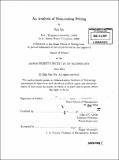| dc.contributor.advisor | John D.C. Little. | en_US |
| dc.contributor.author | Wu, Wei, 1973- | en_US |
| dc.contributor.other | Sloan School of Management. | en_US |
| dc.date.accessioned | 2005-09-27T17:42:31Z | |
| dc.date.available | 2005-09-27T17:42:31Z | |
| dc.date.copyright | 2004 | en_US |
| dc.date.issued | 2004 | en_US |
| dc.identifier.uri | http://hdl.handle.net/1721.1/28682 | |
| dc.description | Thesis (S.M.)--Massachusetts Institute of Technology, Sloan School of Management, 2004. | en_US |
| dc.description | Includes bibliographical references (leaves 63-66). | en_US |
| dc.description.abstract | Prices ending in 9 are ubiquitous. In this paper I first develop a theoretical model of the effect of such prices on sales and review the empirical literature on the topic. Then I use a data set from an online experiment run by Lau (2000) to conduct an empirical study of the effect. Analysis with a logit model indicates that products with 9-ending prices are more likely to be chosen than others but a high fraction of 9-endings decreases the effect. | en_US |
| dc.description.statementofresponsibility | by Wei Wu. | en_US |
| dc.format.extent | 66 leaves | en_US |
| dc.format.extent | 2389671 bytes | |
| dc.format.extent | 2396029 bytes | |
| dc.format.mimetype | application/pdf | |
| dc.format.mimetype | application/pdf | |
| dc.language.iso | en_US | |
| dc.publisher | Massachusetts Institute of Technology | en_US |
| dc.rights | M.I.T. theses are protected by copyright. They may be viewed from this source for any purpose, but reproduction or distribution in any format is prohibited without written permission. See provided URL for inquiries about permission. | en_US |
| dc.rights.uri | http://dspace.mit.edu/handle/1721.1/7582 | |
| dc.subject | Sloan School of Management. | en_US |
| dc.title | An analysis of nine-ending pricing | en_US |
| dc.title.alternative | Analysis of 9-ending pricing | en_US |
| dc.type | Thesis | en_US |
| dc.description.degree | S.M. | en_US |
| dc.contributor.department | Sloan School of Management | |
| dc.identifier.oclc | 59006092 | en_US |
